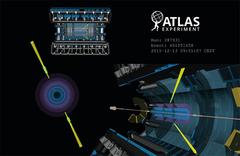URL: https://www.desy.de/news/news_search/index_eng.html
Breadcrumb Navigation
DESY News: Scientists find evidence for light-by-light scattering
News
News from the DESY research centre
Scientists find evidence for light-by-light scattering
Scientists from the ATLAS collaboration at the LHC have found evidence for light-by-light scattering, in which two photons interact and change their trajectory. Researchers from DESY, the Johannes Gutenberg University Mainz and the AGH University of Science and Technology in Krakow performed the study.

In 2012, physicists proposed that light-by-light scattering could be observed in collisions at the LHC. Protons that are accelerated to nearly the speed of light produce a very strong electromagnetic field. The generated field is even stronger when Lead ions are used rather than protons . When two such ions pass each other in a so-called ultra-peripheral collision, two photons can scatter off one another while the ions themselves stay intact. The scientists then observe two low-energy photons with specific kinematic properties and no additional activity in the detector. Based on the data taken in 2015 at the LHC, physicists at the ATLAS experiment conducted a search for light-by-light scattering and found 4.4σ evidence for the phenomenon. The σ-value describes the statistical significance of a scientific result. Physicists usually speak of a “discovery” if they find a 5σ result and call a 3σ result “evidence” for something new. Light-by-light scattering has a very small cross-section, which means that it happens very rarely. Thus in four billionanalysed events, only 13 candidates for such diphoton events were observed.
Because the scientists observed only a few events attributed to light-by-light scattering, the statistical accuracy of their results is limited. When the next lead-lead run at the LHC starts (end of 2018), they hope to collect more data to test this phenomenon more precisely. Further studies could also provide an additional window into new physics at the LHC. “Maybe we can find evidence for physics beyond the standard model of particle physics, for example axion-like particles that are a possible candidate for dark matter. Different theoretical concepts predict that light-by-light scattering can be sensitive to such particles”, says Dyndal.



